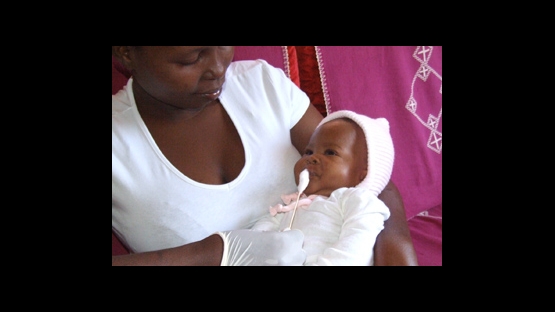Nutrition plays a vital role in early child development. Good nutrition is vital for brain development and healthy growth, which in turn have long-term consequences for the child's capacity to learn at school and his/her abilities at work in adulthood.
Since research has shown that breast milk is a baby's best source of nutrition, the World Health Organization (WHO) recommends exclusive breastfeeding for the first six months of life, followed by the introduction of appropriate complementary foods and continued breastfeeding for up to two years.
Conventional methods to determine the quantity of milk consumed by a baby can be time-consuming. They can also disturb a baby's feeding pattern, as these methods require that the baby is weighed before and after each feeding.
A more accurate, and very informative, alternative method is the deuterium oxide dose-to-mother technique.
This isotope technique, which the IAEA helps Member States master, can help determine if a baby is breastfed exclusively, according to these international guidelines, as well as tell how much human milk is consumed by breastfed infants.
The Science: Deuterium Oxide Dose-to-Mother Technique
A lactating mother drinks a small amount of deuterium oxide (water containing the stable isotope of hydrogen known as deuterium). Within a few hours, the deuterium is distributed throughout her body and is incorporated into her milk.
Over a period of 14 days, samples of saliva are collected from the mother and child, revealing the changes in isotope concentration.
This gives researchers insight into the baby's intake of human milk and whether the baby has consumed water from other sources.
After the mother has taken the dose of deuterium oxide, the deuterium gradually disappears from her body and appears in the body of the baby. Deuterium in the baby's body comes only from the milk consumed during breastfeeding.
As the deuterium is eliminated from the mother's body, the enrichment in her milk declines and therefore, the enrichment in the baby's body also falls.
A mathematical model is used to determine how much of the deuterium given to the mother appears in the baby's saliva. This is related to the amount of human milk consumed by the baby.
The mathematical model also gives an estimate of the amount of water from sources other than the mother's milk, and therefore whether or not the baby is exclusively breastfed.
There is no radiation hazard associated with the use of deuterium, which is completely harmless at the levels used to assess infant feeding practices. Deuterium is naturally present in our drinking water and the food we eat, at very low levels.
Supporting Member States in Analysing Nutrition through Breastfeeding
The IAEA has a number of ongoing Technical Cooperation (TC) Projects and a Coordinated Research Project (CRP) for Doctoral students which use the deuterium oxide dose-to-mother technique to assess whether exclusive breastfeeding is being practiced.
Africa
In the IAEA project (RAF6039) Applying Stable Isotope Techniques to Monitor and Improve Infant and Young Child Nutrition Interventions in AFRA Countries, infant feeding practices are being studied in 12 African countries - Benin, Botswana, Burkina Faso, Central African Republic, Ghana, Kenya, Mali, Morocco, South Africa, Sudan, Tanzania and Zimbabwe.
The study, which began in 2009 and ends this year, assesses the children's growth while taking infant feeding practices into account.
So far, the research has shown that in general, the reported rates of exclusive breastfeeding (from questionnaires) are much higher than the true rates, when objectively measured using deuterium oxide dose-to-mother technique. Data analysis is on-going.
Latin America and Caribbean
In the IAEA project (RLA6071) Evaluating Breast Milk Intake and Body Composition of Infants and Mothers, Measured by Deuterium Dilution, as Indicators of Good Feeding Practices and Nutritional Status, infant feeding practices are being studied in 9 countries in Latin America and the Caribbean - Argentina, Bolivia, Brazil, Chile, Cuba, Dominican Republic, Ecuador, Guatemala and Uruguay.
The project, which started in 2012 and ends this year, is evaluating breastfeeding promotion programmes in Member States by comparing reported breastfeeding habits with quantitatively measured breastfeeding practices. Preliminary results of this project are the same as the ones in Africa, and show that reported rates are much higher than measured rates in most countries.
Asia and Pacific
In the IAEA project (RAS6073) Using Stable Isotope Techniques to Monitor Situations and Interventions for Promoting Infant and Young Child Nutrition, infant feeding practices are being studied in 12 counties in Asia and the Pacific - Bahrain, Bangladesh, Cambodia, Indonesia, Kuwait, Lebanon, Malaysia, Mongolia, Pakistan, Sri Lanka, Thailand and Vietnam.
The project, which started in 2014, will use stable isotope techniques to validate mothers' reported breastfeeding practices with the aim of improving conventional assessment tools and evaluating exclusive breastfeeding promotion programmes.
Education
The IAEA is also training PhD students from Burkina Faso, India, Kenya, South Africa, Sri Lanka and Thailand in nuclear techniques in nutrition Stable Isotope Techniques to Assess Intake of Human Milk and Body Composition of Infants and Young Children up to Two Years of Age. The CRP is using laboratory capacity established through the Technical Cooperation Programme. The final meeting is planned for August 2015.


